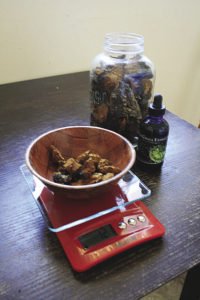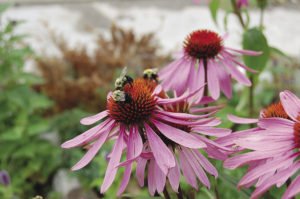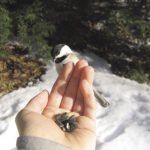In just a few months, another plant growth cycle will renew itself with the onset of spring. Horsetail, spruce tips and nettles are among the early arrivals as they send energy toward the sunlight, forming new shoots and buds of fresh leaves. Because of this, springtime and early summer can be ideal harvesting periods for certain wild edibles, as the new growth contains vital, potent medicine. In other circumstances, herbalists selectively harvest plants in the fall when they go dormant, returning energy to their roots.
For herbalists, making tinctures is a practical way to harness and preserve the medicinal qualities of plants at optimal levels for long periods of time and in concentrated amounts, making them easily portable. The root of an Echinacea plant, for example, is best harvested during dormancy. It can be dried and preserved for use all year round, then bottled and taken by the drop under the tongue or easily diluted in tea, juice or water.
Tinctures are medicines made from herbs mixed with a medium known as the menstruum, which is typically a solution of alcohol and water. Water alone cannot fully extract the medicinal properties from most plants. Other solvents like cider vinegar can be used, but nothing extracts constituents quite like alcohol, allowing a broader spectrum of constituents to be pulled from the herb while preserving the extract at the same time—often for years and sometimes indefinitely, depending on its strength and quality.

Introductory and folk herbalists commonly begin with the basic method of tincture making to build their home apothecary. Aptly called the Simpler’s Method, it requires a short list of tools and ingredients: a jar, the herb and the menstruum—usually vodka or brandy. Chop or pound the herb, place it in the jar, cover completely with alcohol and seal it with an air-tight lid. Tinctures are generally left for up to six weeks and then strained, with the remaining liquid stored in a dark place away from sunlight. That’s all there is to it.
Last fall, I tried tincturing Echinacea root to prepare for cold and flu season. E. purpurea, also called Purple Coneflower, is a valuable medicinal used in preventative medicine that boosts the immune system, although E. angustifolia is the more desired species. This hardy perennial attracts pollinators and is a common, showy ornamental for horticulturalists and gardeners. It grows well in our Lake Superior region, blooming tall, conical flowerheads with pinkish-purple petals. Echinacea can be harvested by carefully digging up a portion of a mature, well-established root and giving it a good scrub before making the tincture. The roots are tough and fibrous, and can be pounded with a mortar and pestle, or chopped up, before adding the menstruum and alcohol.
While the Simpler’s Method is a great start for home use, commercial herbalists favour less guesswork and more math to calculate more precise plant to liquid ratios. Depending on the type of herb, the plant part, or whether it’s fresh or dried, the tincturing formula for one can differ from another because of variables like water content. Tinctures are taken by the drop, so using a formula helps ensure that the medicine’s strength is consistent from batch to batch.
You can use the Simpler’s Method or more calculated ratios for many of the medicinal herbs in your own garden or in the wild—just be sure that you’ve positively identified what you’re working with, and research dosage and safety information from credible sources. If you have an existing health condition, or are pregnant or breastfeeding, consult your healthcare provider before experimenting with herbal medicines. Just because it’s natural, doesn’t always mean that it’s safe for you to ingest.

Herbalism continues to offer health and healing for millions of people around the world. But if you’re unable to grow or harvest herbs where you live, don’t get discouraged—there are several dispensaries online that sell quality herbs.
Inspired by the power of plants for self-healing, and driven by the desire to connect with the natural world, herbalism has shown me that Nature’s medicine is growing all around us, often in our backyards and gardens. Making your own medicine can be an empowering experience that saves you money and opens doors to a practice that’s rooted in culture, and counseled by tradition—one that includes science but has existed long before modern medicine.




